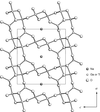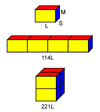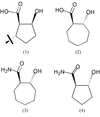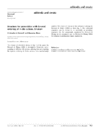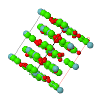issue contents
December 2004 issue

Cover illustration: Crystal packing diagram of 1,4-benzoquinone with Hirshfeld surfaces. The translucent gray surfaces illustrate the nature of these novel surfaces and how they envelop each molecule and reflect the presence of neighbouring molecules. Colours mapped on the central surface represent the distance from the surface to the nearest nucleus in an adjacent molecule: red (shortest), through green, to blue (longest). Courtesy of McKinnon, Spackman & Mitchell [Acta Cryst. (2004), B60, 627-668].
topical reviews
Hirshfeld surfaces reflect intermolecular interactions in a novel visual manner, and features characteristic of different interactions can be revealed and highlighted by colour mapping of a variety of functions. A complementary two-dimensional mapping provides a quantitative summary of the intermolecular contacts experienced by molecules in the bulk. These tools provide a new approach to exploring packing modes and intermolecular interactions in molecular crystals, and are used to compile a comprehensive pictorial glossary of intermolecular interactions.
research papers
Download citation


Download citation


The structure of CrF3 has been studied in the pressure range from ambient to 9.12 GPa. It was found that volume reduction is achieved through rotation of the CrF6 octahedra, and a small octahedral strain was found to develop during compression. The zero-pressure bulk modulus Bo and its pressure derivative B were determined to be Bo = 29.2 (4) GPa and
were determined to be Bo = 29.2 (4) GPa and  = 10.1 (3).
= 10.1 (3).
Group-theoretical methods have been used to enumerate structures that arise when B-site cation ordering, as may occur in the 1:2 and 1:3 ordered perovskites A3BB X9 and A4BB
X9 and A4BB X12, is combined with simple octahedral tilting. The numbers of possible structures are 10 and 11 for the 1:2 and 1:3 ordering patterns, respectively.
X12, is combined with simple octahedral tilting. The numbers of possible structures are 10 and 11 for the 1:2 and 1:3 ordering patterns, respectively.
Crystal structures of stable and metastable Ge2Sb2Te5, which is a material for phase-change memory, were investigated in detail by powder X-ray diffraction using SPring-8, a synchrotron radiation facility.
Download citation


Download citation


The anions of Na0.8Ti1.2Ga4.8O10 form a network that includes tunnels, within which the Na+ ions are found. The distribution of the Na+ ions, which may have large displacements from their mean position, was determined from X-ray diffraction data measured at 299, 173 and 123 K.
The short-range ordered structure of the cations in α-LiFeO2 was analysed by transmission electron microscopy and electron diffraction. The short-range ordering in α-LiFeO2 is usually characterized by octahedral clusters, but it has been found that a local cation ordering is also characterized by both an alternate-distribution model and by cubic clusters.
Download citation


Download citation


The first-order transition in K2Cr2O7 between phases I and II is fully described. A comparable transition between phases IIb and I is likely but not between phases II and IIb. An intermediate phase may exist between phases IIb and I.
Download citation


Download citation


The crystal structures of lithium bis(oxalato)borate salts solvated with water, acetonitrile, acetone, dimethoxyethane, 1,3-dioxolane and ethylene carbonate are reported.
The analysis of histograms of pattern coefficients (cell length/molecular dimension) for thousands of crystal structures has shown that molecular crystal structures are fundamentally very similar to one another.
Download citation


Download citation


An artificial data set, produced by scaling and merging six independent and individually unsatisfactory data sets from different crystals, has permitted the successful redetermination of the structure of the title compound, C12H8Br2O.
Download citation


Download citation


Open  access
access
 access
accessThe synthesis and crystal structures of six new per-substituted spermine-bridged cyclotriphosphazenes, [N3P3X4(NHCH2CH2CH2N)CH2CH2]2 (where X = OPh, [spiro-O(CH2)3O]0.5, Ph, NHPh, NC4H8 and NHBut, respectively) are reported and the observed relationship between molecular parameters of the N3P3 ring and substituent basicity constants is discussed.
Open  access
access
 access
accessThe geometry of the  graph set formed between a 2-aminoheterocyclic ring containing an Nsp2 atom (in the 1-position of the ring) and a carboxylic acid has been studied by collating data from known structures from the CSD. Unexpected differences were found to occur between both the non-hydrogen contact distances, and specific bond distances and angles of the heterocycle.
graph set formed between a 2-aminoheterocyclic ring containing an Nsp2 atom (in the 1-position of the ring) and a carboxylic acid has been studied by collating data from known structures from the CSD. Unexpected differences were found to occur between both the non-hydrogen contact distances, and specific bond distances and angles of the heterocycle.
Download citation


Download citation


The polymorphism of trans-2-hydroxycycloheptanecarboxylic acid with virtually the same unit cell is a special case of two-dimensional isostructurality with alternating (parallel versus antiparallel) layers. A similar phenomenon is exhibited by the analogous trans-2-hydroxy cycloheptanecarboxamide and its cyclopentane homolog.
addenda and errata
Free 



 journal menu
journal menu















